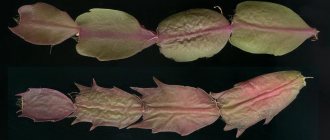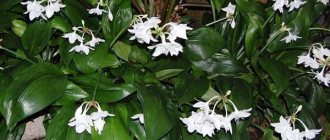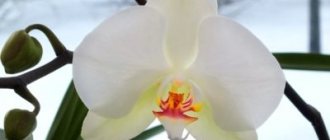Among succulents grown indoors, a prominent place belongs to the charming and unpretentious Decembrist. Its ability to bloom during the sun-deprived winter period has won the love of gardeners in the northern hemisphere.
And the decorative appearance and variety of varieties are additional incentives for lovers of tropical flora to purchase this flower for their collection.
Flower Decembrist: description
The natural habitats of the Decembrist are the high mountain forests of Brazil, from where this cactus was brought to the countries of the Old World a little more than two hundred years ago.
Interesting! The synonymous series of scientific names of the genus Decembrist consists of several positions: Schlumbergera, Epiphyllanthus, Zygocactus, Epiphyllum, Zygocereus.
In addition, the cactus bears names associated with the period of its flowering: Christmas, Decembrina. All Dekabrist varieties have a number of common characteristics:
- these are perennial plants that in nature lead an epiphytic lifestyle, but at home they grow as potted crops;
- cacti - low bushes (about 1 meter) with strong branching and abundant flowering;
- flat stems have a soft structure and consist of many joints decorated with denticles or notches;
- the insignificant and vulnerable root system is located superficially;
- no thorns;
- the color of the tubular flowers varies from white to lilac , including all shades of red-pink;
- Flowering occurs from November to February and is characterized by prolonged opening of the buds.
Decembrist can be confused with its distant relative Ripsalidopsis. But upon closer examination, Schlumbergera and Ripsalidopsis are noticeable.
In Decembrist, the stem segments have a pronounced jagged edge, the corollas of the flowers are asymmetrical; The articulations of Ripsalidopsis are almost smooth, the flower petals are of the same length and pointed. But the main difference is in the timing of flowering: Decembrist forms buds at the beginning of winter, and its relative - in the spring, closer to Easter.
Propagation of Schlumbergera by cuttings
At first glance, it may seem that it is difficult to propagate Schlumbergera from cuttings. However, it is easier than it seems. To break off the stalk, you need to rotate it around its axis several times. Then the cuttings are dried and planted on moist soil. Their root system begins to develop quickly. At first the new plant will not show any signs of growth. But soon the buds will begin to appear.
There is also another interesting feature of the Decembrist. It can be propagated by grafting onto another plant. To do this, you need to cut off the top of another plant, make a cut on the stem and place a Decembrist cutting there. The junction is tied with thread. It can be removed after the plants grow together.
Schlumbergera corolla colors
Decembrist, as a representative of the bright Brazilian flora, stands out for the variety of colors and intensity of the color of its buds. Flowers of natural species found in indoor culture are distinguished by a rich red hue.
Specimens of Schlumbergera varieties shine with tints of pink, red and cream colors. Among the variety of varieties you can find white Decembrist, as well as plants with yellowish and two-color buds. As an exception, there are Decembrists with orange and even purple shades of corollas.
Ripsalidopsis and Schlumbergera or does Decembrist bloom in spring
Sometimes Decembrist owners claim that their pet blooms in March-April, showing photographs as evidence. If you look closely at the plant in the image, it most often turns out that instead of Schlumbergera, another epiphytic cactus, Ripsalidopsis, which looks very much like Decembrist, has bloomed its bright red flowers in the pot. It is also called the Easter star, since the peak of its flowering is observed in April.
Although even among the Decembrists you can now find more than one variety. As a rule, the following flowers bloom on our windowsills:
- Schlumbergera truncated (truncatus) and
- Another hybrid is Schlumbergera bucklei.
Take a look at the photo, it is noticeable that the plants differ in the shape of the stem segments. In ripsalidopsis their edges are smoothed and rounded, in S. buckleya they are more pronounced, and in S. truncata they are sharply jagged.
And in this photo we note the difference not only in the appearance of the segments, but also in the structure of the flower.
On the left is ripsalidopsis, in the center is Sh. truncated, on the right is Sh. boucleia.
If in both species of Schlumbergera there is bilateral symmetry of the flower, it is slightly truncated, then in Ripsalidopsis the inflorescence is radially symmetrical and has the appearance of a pointed star.
Summarizing what has been said, we can draw the following conclusion: in November – January, Schlumbergera bouclei (the so-called “grandmother’s Decembrist”) blooms, in December-February it passes the baton to Schlumbergera truncated, and in the spring we admire the flowering of ripsalidopsis.
| Rhipsalidopsis |
Someone will object: how can we evaluate the flowering of zygocacti, which we see in garden centers throughout the year, including at the height of summer? It’s very simple: this is the result of modern equipment in greenhouses, in which you can create any conditions for forcing and lush flowering at the right time of year.
Popular types and varieties of Zygocactus
In indoor culture, according to GRIN - Genetic Resources Information Network, gardeners breed 9 main species of Schlumbergera. These species are the basis for the breeding work of cactus growers all over the world; on their basis, a large number of varieties and hybrids of Zygocactus have been created. Research by specialists is ongoing, thanks to which new varieties of this sought-after plant continue to be registered every year.
Photos help to identify some features of the main varieties of Decembrist.
Buckley
The most common Dekabrist variety, characterized by an increased ability to adapt to care and special resistance to diseases and pests. Can be grown as a hanging plant.
The cactus grows up to half a meter in height, has soft segments of stems of a dark shade of green, which become coarser at the base as the plant matures. The flowers are large, tubular in structure, painted in different tones of pink and lilac.
Schlumbergera Buckley has a long flowering period: from late autumn to March.
Schlumberger truncated
This variety is one of the basic ones for breeding. The height of the plant does not exceed 0.5 m. Both erect and hanging forms are cultivated.
Decabrina is distinguished by small light segments with sharp notches along the contour. The flowers are large, with curved petals, painted in various shades of crimson, less often in other tones.
Kautsky
The Decembrist variety, reminiscent of Sh. truncated - at one time these varieties were considered related subspecies. But due to its smaller dimensions, Kautsky’s Decembrist has been relegated to the category of an independent species.
It is distinguished by the purple tonality of its buds.
Microcylindrical
This succulent is distinguished by the cylindrical shape of all segments. The color of the buds varies from white to lilac shades.
The plant begins flowering in March.
Rousseliana
A low variety of Decembrist (about 30 cm), which is capable of growing long, almost meter-long, creeping stems. It is characterized by increased resistance to adverse conditions.
The plant blooms from February to April, producing many pink buds.
Orsichiana
A peculiarity is the color of the corolla petals with a noticeable color transition from reddish at the edges to white-pink in the center .
Able to form buds 3 times a year: March – August – November.
Opuntia
The succulent belongs to a variety rarely found in collections. A characteristic feature is the presence of white areoles with long spines, due to which the Decembrist segments resemble the stems of Opuntia.
The stems can reach more than a meter in length. It blooms in spring with large corollas of pink-violet shades.
The distinctive features of Decembrist varieties and hybrids can be seen in the photographs below.
Christmas fantasy
Gertner
Pasadena
Golden cream
Lavender doll
Aspen
Windsor
Mix
Lavender fantasy
Christmas flame
Sanibel
Kris Kringle
Malissa
Santa Cruz
Christmas mood
Twilight tangerine
Cambridge
Bridgeport
Golden fever
Peach parfait
Dark Eve
Madame Butterfly
White Christmas
Types of Schlumbergera domestica with photos and names
Schlumbergera truncates
The stems of this species diverge from the middle and hang beautifully in different directions. The shoots can reach 40 cm. The segments have sharp teeth on the sides. Schlumbergera truncata flowers come in a wide variety of shades.
There are also several varieties of this species
Bridgeport
This plant is distinguished by its flowers, or rather their color. Plants of this variety are called snow-white Schlumbergera. Most often, the flowers are white and round in shape. Sometimes pinkish flowers are also found.
Cambridge
This variety differs in the color and shape of the flower. At the beginning of flowering, you can see peach buds and blooming flowers. But over time they will turn yellow.
Christmas Charm
The red purple color indicates that it is a Christmas Charm plant. This color is the most common. However, different shades of pink can also be found. This variety of Schlumbergera grows quickly, making it perfect for a hanging pot.
Kris Kringle
The plant also produces bright red flowers. The variety is also distinguished by short segments and compactness.
Lavender doll
This variety, on the contrary, is characterized by long segments. The flowers are large, lavender in color. To get a vertical bush, the plant must be pinched every year.
Peach Parfait
The plant is characterized by vertical growth. Therefore, it is better to place it in a regular pot rather than in a hanging one.
Santa Cruz
This variety is characterized by bright red-orange flowers. It also differs in that the buds begin to take on bright colors early.
Twilight Tangerine
The plant is notable for its light orange or light pink flowers and wide stems.
Decembrist: care at home
Being a not very demanding crop in terms of cultivation, the Brazilian cactus prefers regular and attentive care, with strict adherence to all agrotechnical regimes.
Lighting and placement
Decembrist under natural conditions grows under a canopy of tree branches, so it genetically does not tolerate the long-term influence of the hot rays of the sun. Bright lighting is one of the reasons why Decembrist leaves turn red.
But without sufficient daylight, the cactus will not receive the necessary conditions for the formation of buds.
Important! The optimal location for the Decembrist is considered to be on the western and eastern windows, where suitable light activity is created and direct sunlight is excluded.
Southern window sills are also suitable, provided the plants are shaded during the summer afternoon hours. On the windows of the north side, a lack of lighting is guaranteed for the Decembrist , so additional lighting with daylight spectrum lamps should be considered. In this case, the question of how to make the plant bloom on time will be resolved.
Temperature
The thermometer readings within +17 + 22 °C are suitable for the Decembrist. This temperature must be maintained throughout the spring and summer.
As cold weather approaches, the temperature should be lowered slightly (by 2–3 degrees) to create a comfortable environment for the Decembrist to form buds. During flower blooming, such temperature indicators will increase the flowering period.
Attention! It is necessary to protect the cactus from sudden temperature changes, since drafts and hypothermia can disrupt the flowering schedule of the Decembrist. It is the violation of the temperature regime that is the main reason why the cactus does not bloom.
After the flowers fall, the plant needs a mandatory rest: it must be moved to a cool room with optimal lighting.
Soil and fertilizing requirements
The root system of the Decembrist is poorly developed, so the substrate for the plant should be selected as nutritious, light, with good aeration and water permeability.
Throughout the active growing season, Zygocactus must be fed monthly with a solution of mineral fertilizers.
Attention! It is prohibited to feed recently transplanted or sick specimens.
Watering mode
Each subsequent watering is carried out after slightly drying the upper part of the earthen substrate.
Regular and moderate soil moisture is one of the main rules on how to care for the Decembrist so that it blooms at its proper time. Drainage at the bottom of the pot is also required to protect the roots from rot.
Transfer
The Decembrist has a negative attitude towards any interference in the processes of his life. This also applies to cactus transplants. When deciding how to replant a plant, it is advisable to give preference to the transshipment method.
Young plants, due to their rapid growth and development, need to replace the pot and substrate annually. Older specimens can grow in one pot for about five years.
Advice! The health of the Decembrist root system, and therefore the well-being and decorativeness of the entire plant, depend on the presence of a drainage layer at the bottom of the flowerpot.
Trimming
For Schlumbergera, pruning is necessary. It stimulates the branching of plant stems, which promotes the formation of more buds on newly formed shoots and more luxuriant flowering.
Decembrist pruning is done after the last flower has dried: you should manually remove all the dried corollas and remove part of the young growth along the line of articulation of the stem segments.
This video shows how to prune Decembrist for lush flowering.
Transfer
Truncatas are replanted after flowering, at the end of February. Young bushes are replanted annually, adults - once every 4 years.
The pot should be low; when replanting, the diameter of the pot increases by 2-3 cm. The soil should be light and loose so that the roots receive a sufficient amount of air. Use ready-made peat soil or mixture:
- turf;
- sand;
- coal;
- leaf humus.
Brick chips or small stones are placed in the pot as drainage.
Reproduction of the Decembrist flower
Obtaining young specimens of Schlumbergera is possible in two ways: by seeds and individual parts of the stem. The procedure should be carried out in the spring.
The simplest and most accessible is propagation by shoots. You should carefully break off a part of a healthy, young stem along the border of the articulation. The main thing is that the process must have at least 3 segments.
The grower himself must decide how to plant the shoot. You can root the cuttings in water and then plant them in a flowerpot, or you can dry them until a film forms and immediately place them in a substrate for rooting at the site of future growth.
Reproduction of Decembrist by seeds is a more labor-intensive process. To figure out how to grow a healthy plant from seeds, you need to take the advice of experienced cactus growers.
The first stage is obtaining a seed by cross-pollinating two flowers. The seeds will ripen in approximately 8 months.
The second stage is peeling the seeds from the fruit skin, treating them with disinfectants and planting them in a substrate without covering them with soil. To guarantee germination, you can build a mini-greenhouse.
Difficulties of maintenance
- It is important to prevent the flower from overcooling. The stems become brown; you should adjust the air temperature or move the pot to a warmer and brighter place.
- If the leaves have lost their elasticity and freshness, become wrinkled and lifeless, the watering regime has been disrupted. If there is a lack of moisture, it is necessary to add spraying and increase the amount of water when watering.
- Due to excess moisture, Decembrist truncated can shed its leaves. You should stop watering for several days and, if necessary, replace the top layer of the substrate. It is necessary to examine the root - cut off the rotten areas, replant the flower, treat the soil and bush with fungicides containing chlorothalonin.
- Moderate doses of fertilizers should also be observed. Weak roots cannot absorb large amounts of mineral fertilizers; the flower may die from an overdose.
- The drug "Vitaros" will save you from fungal infections - fusarium, late blight, which affect the root and root collar.
- Fungicides are not usually used to treat bacterial diseases.
This will require urgent pruning, replanting or cuttings of healthy stems. The sections are treated with charcoal or a weak solution of potassium permanganate. Important! When treating, an infected flower must be isolated from other plants - the infection spreads quickly. - Schlumberger truncata is quite hardy against insects and pests. But with stagnant air humidity and a damp substrate, the leaves can be affected by aphids or scale insects. The bush will need to be treated with soapy water.
- To prevent diseases and pests, it is necessary to treat the substrate and stems with foundationazole or a solution of Bordeaux mixture.
In order for the truncated Decembrist to delight you with its festive blooms every winter, you must follow all the rules of care and “personal hygiene” of the tropical flower.
Plant pests and diseases
With proper and regular care, the Decembrist is quite resistant to various diseases and parasites.
Carefully! Mistakes by gardeners in maintaining Schlumbergera weaken the plant, which can lead to disease or insect damage.
Insects dangerous to plants
Pests include spider mites, thrips and mealybugs. The affected plant must be quarantined, treated with insecticides, and errors in maintenance that caused it to weaken must be corrected.
Infections
Diseases affecting Schlumbergera are of different nature. Fungal pathogens are dangerous for the plant, the appearance of which causes late blight, cladodia rot and fusarium. There is also a bacterial disease - rot of the base of the stem.
Among the treatment methods, we can recommend the correction of care regimens, treatment with fungicides and pesticides, cuttings of a cactus in order to save it in case of severe damage.
What problems may arise in caring for Schlumberger's?
Zygocactus is a heat-loving plant, quite sensitive to temperature and humidity. Often a neglected flower may lose its luxurious appearance and not bloom. What reasons could lead to the deplorable state of the Decembrist?
- Stunted growth. If your cactus becomes stunted or twisted, carefully inspect it for mealybug infestation. These pests look like tiny white cottony specks. They move slowly and often appear first on the lower surface of a segment or in darker, moist areas near the base of the stem. Beetles feed on plant sap and leave behind sticky honeydew, which causes mold to form on the plant.
- Yellowing, spotted or wilting leaves or stems . If you notice yellowing of stem segments, their spotting or wilting, carefully inspect the flower for the presence of thrips. These pests appear as thin black stripes or tiny insects. Damage to stems is not caused by thrips, but by a virus that they usually carry. Treat your plant immediately with insecticidal soap or another product. It may be necessary to transfer the Decembrist to a new sterile pot with fresh soil mixture. Wilting can also be caused by insufficient light, insufficient water, or a pot that is too cramped. Correct these problems and watch closely for improvements in growth.
- The stems turn red or pink. When Decembrist receives too much sun or too little water, a change in the color of the branches occurs. In this case, it is worth moving the flower pot to a more shady place with partial lighting. Also try to control the frequency of moisturizing.
But these are not all the problems that Zygocactus may encounter.
Preparing the Decembrist for flowering
The process of preparing the cactus for the flowering period begins in the spring. During the active growing season, the plant grows new shoots, on which buds will then appear.
You can help the plant during this period by maintaining optimal conditions - sufficient lighting, proper watering and fertilizing, ideal temperatures.
In autumn, the formation of buds begins . There will be more of them with proper pruning, going through a resting phase and lowering the temperature to optimal levels.
Advice! At a time when the Decembrist is blooming, the pot with the plant should under no circumstances be moved or simply moved from its place. This is fraught with the discarding of already formed buds.
The usual flowering time for Schlumbergera is from November to early February. The reason why the Decembrist blooms in March can be attributed to violations in its maintenance: high indoor temperatures in winter do not allow the cactus to bloom on time.
This video tells how to care for the Decembrist in summer and autumn.
Flower maintenance and care
Schlumbergers do not tolerate either excessive moisture or drying out. But from my own experience I will say: it’s better to dry it out than to flood it. A dried out flower recovers much better than a flooded one. Most often, the only salvation for a flooded flower is to cut off segments of its leaves and root again, because the roots quickly rot.
Schlumbergera life cycle table at home
| Months Cycle | Lighting | Humidity, watering | Temperature | Additionally |
| September-October Rest, preparation for flowering, formation of flower buds | Slight shading | Watering infrequently as the soil dries out. No need to spray. | Reduction to +15–18. You can leave it on the balcony, but don’t let it drop below +15! | Fresh air flow, but not drafts. In October, feed once with complex fertilizer for cacti. |
| November-January Flowering period | Scattered light | High humidity. Spray. Watering is regular. Do not allow the soil to dry out completely. | +18–22 | Fertilize with fertilizer for flowering plants twice a week or once every ten days with fertilizer for cacti. You cannot change the conditions of maintenance or rotate the flower. |
| February-March Rest, preparation for the growing season | Slight shading | Moderate watering | +15–18 | Pinch off the end segments to form a crown. Fertilize once with cactus fertilizer. |
| March - September Growing season | Scattered light | Regular watering | +18–20 | Application of complex fertilizers once every 2 weeks. Ventilation. Transfer if necessary. |
| June-August Growing season, preparation for dormancy. | Scattered light | Spray regularly with warm water. Have a warm shower. Regular watering | +18–25 | Keep outdoors or ventilate. Fertilize once every two weeks with cactus fertilizer. |
Not every gardener has the desire and time to follow the maintenance regime according to the scheme. If your Decembrist grows on your window, then you don’t have to give it a rest period. The main thing is to know the basic conditions necessary for it:
- Temperature . The Decembrist does not like either cold or heat. The best temperature for it is room temperature, without sudden fluctuations, not lower than +15 degrees and not higher than +25. Can withstand short-term temperature drops down to +5 degrees. At temperatures below +12 degrees, it does not set flower buds.
- Fresh air . The Decembrist needs fresh air. Ventilate it. With the beginning of spring, the flower can be taken out onto the balcony. Doesn't like drafts.
- Humidity, spraying . The humidity required is quite high, because in nature this flower receives moisture not only through the roots, but also through the leaves and aerial roots.
If kept cool, do not spray during the dormant period. At any other time, you can spray the leaves even during flowering. The main thing is that the water is soft and warm. You can use boiled one.
Decembrist flowers are not afraid of water
- Watering, shower . Schlumberger likes moderate watering, when the clod of earth dries two cm. But during flowering, watering increases. When there are no flowers, it is useful to give the Schlumberger a warm shower. At the same time, cover the ground with cellophane so that water does not get into the soil!
When watering, do not pour too much water. Use only warm and settled (about a day) water. If your water is hard and contains impurities, then water it with filtered water or, in extreme cases, boiled water.
If you have dried out the plant and its leaves have wrinkled, then water it and spray it. He will quickly restore his healthy appearance. But of course, if you have dried out a large Decembrist so that all its roots have dried out, then it is better to pinch off the branches and plant again.
- A change of scenery . Schlumberger is intolerant of drastic climate change. Do not under any circumstances change the orientation of the Decembrist plant during flowering, otherwise the flowers and buds may fall off. You can move it without turning it towards the light. But it’s best to wait until flowering ends.
- Clean leaves. In nature, Schlumbergera receives nutrition and water mainly from aerial roots and leaves. Therefore, it is necessary to ensure that the leaves are clean from dust. You can wipe them with a damp cloth or sponge. After wiping or showering, you can walk over the leaves with the back of a banana peel or with a yolk diluted in water. This is also additional nutrition.
The Decembrist came to me completely by accident. I found two pieces near the garbage chute. I picked it up because I’m “sick” when it comes to flowers and am dragging home any shoots that turn up. I put it in the water. I decided to search the Internet to see what I found.
Previously, I had no business with the Decembrists and did not pay attention to them. After searching the Internet, I became convinced that my foundling was nothing more than a Schlumbergera or simply a Decembrist. But while I was looking, I saw a variety of species and somehow immediately decided that I wanted “with white flowers.”
My Decembrist began. And, imagine, it bloomed with white flowers! Then a yellow one appeared. ))) Now I want other shades. It's a pity, the window sills don't allow it. It is completely unpretentious in care. I water it when the soil dries out. Sometimes I feed it.
In the summer I send it to the loggia and keep it there until it gets cold. In the summer I feed more often in company with hippeastrums. Then I take it home and watch the buds grow. :)
Valentina
https://otzovik.com/review_3199397.html
Signs and superstitions
All signs associated with the early flowering of Schlumbergera promise good luck and an improvement in the financial situation in the family for the entire next year.
When a cactus blooms on time for a creative person, it promises the owner new horizons in his work.
The lush bloom of a cactus is associated with a lot of positive emotions in the house. But this does not mean that the Decembrist flower is a donor or a vampire. Simply, the happier the people in the house, the more care they give to the plant. And it responds to love with abundant flowering.
The variety of Decembrist varieties allows you to choose specimens that meet the tastes of each cactus grower. And its unpretentiousness and ability to adapt make it possible to grow this plant in the collections of beginners. The main thing is to follow care regimens and treat your pets with love.
What should be the soil mixture for cacti?
Taking into account the fact that the presented type of cactus is an epiphyte, under natural conditions it grows in crevices of tree bark. Of course, you can’t do this at home, but you can plant the plant in airtight and loose soil.
Flower growers who have been growing this variety of zygocactus for many years are advised to pay attention to the following soil composition:
- 1 part leaf soil;
- 1 part coarse sand.
To make the soil even “richer”, it is advisable to add a little peat or charcoal to this mixture.
Schlumbergers are replanted no more than 1-2 times a year. The manipulation is carried out during the growing season, which occurs at the end of March - mid-April. If the cactus grows slowly, then you can wait a while with the procedure. For replanting, be sure to take a new pot, which is a couple of centimeters larger than the previous one.
Important! Large pots are not suitable for cacti, so you should not buy a flowerpot “to grow.” In such a container, the plant may begin to die.
It is necessary to lay drainage at the bottom of the pot. It can be broken brick, polystyrene foam or expanded clay. The thickness of the “pillow” should ideally be about 2 cm.
Care tips from experienced gardeners
Many lovers of home flowers believe that the Decembrist
- one of the most effective plants that successfully fits into the home interior. Plus, the flower does not require special attention and complex care, although there are still some special care features for it.
Experienced flower growers advise those who want to add an unusual cactus to their collection to follow some rules, namely:
* Never transfer Decembrist
from place to place. He can't stand it. It is not even recommended to rotate it around its axis. This concerns, first of all, the moment of flowering.
* All these changes will force your flower to re-adapt to the surrounding conditions. At such moments, the plant can easily refuse to bloom.
* The plant should be updated from time to time. To do this, simply pick a branch and root it in the ground. This plant has a very high survival rate.
A young plant can bloom within two years.
There is no need to be afraid of the flower rejuvenation procedure. Sooner or later, almost every plant will need such a procedure.











